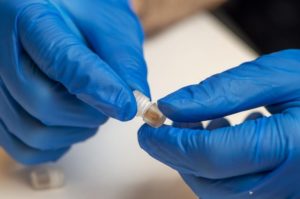Looking back at 2020, we would like to share with you some of the great research that has been published in RSC Advances over the year. We are proud to present a selection of the most popular 2020 biological chemistry papers, reviews and HOT articles published so far.
We hope you enjoy reading these articles and as always, all our articles are open access – free to read and accessible to everyone.
| RSC Advances in the news |
Smart capsule for non-invasive sampling and studying of the gastrointestinal microbiome
Jose Fernando Waimin, Rahim Rahimi et al. DOI: 10.1039/C9RA10986B
The study by Rahim Rahimi and colleagues was published in April and was covered in several news outlets. Purdue University News describes the invention: Purdue University researchers built a way to swallow a tool that acts like a colonoscopy, except that instead of looking at the colon with a camera, the technology takes samples of bacteria. The technology could also move throughout the whole GI tract, not just the colon. This tract, in addition to the colon, includes the mouth, esophagus, stomach, pancreas, liver, gallbladder, small intestine and rectum. Essentially, this tool would make it possible to conduct a “gut-oscopy”. A video showing how it would work is on YouTube.
‘It’s all about being able to take samples of bacteria anywhere in the gut. That was impossible before,’ said Rahim Rahimi, a Purdue assistant professor of materials engineering.
| 2020 HOT articles |
Over the year, our reviewers and Associate Editors have handpicked articles of particular interest and marked them as HOT. We are very pleased to highlight some outstanding 2020 biological chemistry HOT articles:
Molecular crowding induces primer extension by RNA polymerase through base stacking beyond Watson–Crick rules
Shuntaro Takahashi, Naoki Sugimoto et al., DOI: 10.1039/D0RA06502A
 In their article Shuntaro Takahashi, Naoki Sugimoto and colleagues investigated the effect of chemical environments on gene replication of the virus RNA polymerase, providing insight into not only the evolution of life but also the mechanism of mutation of the virus genome including SARS-CoV-2.
In their article Shuntaro Takahashi, Naoki Sugimoto and colleagues investigated the effect of chemical environments on gene replication of the virus RNA polymerase, providing insight into not only the evolution of life but also the mechanism of mutation of the virus genome including SARS-CoV-2.
“The stability of the Watson-Crick base pair is NOT always the most stable, which can be perturbed by molecular environments. Therefore, we speculated that the replication of nucleic acids in the enzyme could also be affected by molecular environments and cause replication errors”, says Professor Sugimoto. “We were excited to find the replication rules became dependent on the stacking interactions more than Watson-Crick base pairing under molecular crowding conditions. This indicates that the replication error can be simply explained by the changes in dielectric constant.”
 Their results suggest that the molecular environment could take part in the evolution of life by enhancing the replication error of genome sequences and highlight the significance of molecular environments of patients’ cells for spreading viruses.
Their results suggest that the molecular environment could take part in the evolution of life by enhancing the replication error of genome sequences and highlight the significance of molecular environments of patients’ cells for spreading viruses.
Read the interview with the authors about their article here.
More HOT articles
Aggregation of biologically important peptides and proteins: inhibition or acceleration depending on protein and metal ion concentrations
Benjamin Gabriel Poulson, Mariusz Jaremko et al., DOI: 10.1039/C9RA09350H, Review
Lophiostomin A–D: new 3,4-dihydroisocoumarin derivatives from the endophytic fungus Lophiostoma sp. Sigrf10
Ziling Mao, Ligang Zhou et al., DOI: 10.1039/D0RA00538J
Read the full HOT article collection
| Most popular 2020 articles |
Reviews
Nanozyme-based catalytic theranostics
Yanan Zhang, Kelong Fan et al., DOI: 10.1039/C9RA09021E
G-Protein coupled receptors: structure and function in drug discovery
Chiemela S. Odoemelam, Philippe B. Wilson et al., DOI: 10.1039/D0RA08003A
Antimicrobial peptides from Bombyx mori: a splendid immune defense response in silkworms
Jannatun Nesa, Octavio L. Franco et al., DOI: 10.1039/C9RA06864C
Papers
Anti-HIV drug repurposing against SARS-CoV-2
Peng Sang, Li-Quan Yang et al., DOI: 10.1039/D0RA01899F
Merits of photocatalytic and antimicrobial applications of gamma-irradiated CoxNi1−xFe2O4/SiO2/TiO2; x = 0.9 nanocomposite for pyridine removal and pathogenic bacteria/fungi disinfection: implication for wastewater treatment
Gharieb S. El-Sayyad, Mohamed Gobara et al., DOI: 10.1039/C9RA10505K
An atomic resolution description of folic acid using solid state NMR measurements
Manasi Ghosh, Krishna Kishor Dey et al., DOI: 10.1039/D0RA03772A
Characterization of insulin cross-seeding: the underlying mechanism reveals seeding and denaturant-induced insulin fibrillation proceeds through structurally similar intermediates
Mohsen Akbarian, Ali Akbar Moosavi-Movahedi et al., DOI: 10.1039/D0RA05414C
iTRAQ-based proteomic analysis reveals several key metabolic pathways associated with male sterility in Salvia miltiorrhiza
Ruihong Wang, Hongbo Guo et al. DOI: 10.1039/C9RA09240D
Natural deep eutectic solvent supported targeted solid–liquid polymer carrier for breast cancer therapy
Xianfu Sun, Mariappan Rajan et al., DOI: 10.1039/D0RA03790G
Lessons learned in engineering interrupted adenylation domains when attempting to create trifunctional enzymes from three independent monofunctional ones
Taylor A. Lundby, Sylvie Garneau-Tsodikova et al., DOI: 10.1039/D0RA05490A
An intermolecular-split G-quadruplex DNAzyme sensor for dengue virus detection
Jeunice Ida, Theam Soon Lim et al., DOI: 10.1039/D0RA05439A
 Submit to RSC Advances today! Check out our author guidelines for information on our article types or find out more about the advantages of publishing in a Royal Society of Chemistry journal.
Submit to RSC Advances today! Check out our author guidelines for information on our article types or find out more about the advantages of publishing in a Royal Society of Chemistry journal.
Keep up to date with our latest HOT articles, Reviews, Collections & more by following us on Twitter. You can also keep informed by signing up to our E-Alerts.











